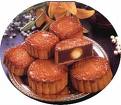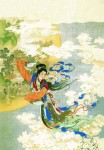Posts Tagged ‘Mid-Autumn Festival’
Foods and Festivities
Zongzi (rice dumpling) Dumplings are a kind of folk food with a long history, and are loved by the common people. Just as the old saying goes, “Nothing tastes better than dumplings.” For a long time in the past, having a meal of dumplings sometimes meant improvement of life. As for the history of dumplings, we can use the term “age-old” to describe it. The earliest recorded history associated with dumplings is found from the Han Dynasty. In the 60’s of the 20th century, a wooden bowl was excavated from a Tang Dynasty (618-907 A.D.) tomb in the Xinjiang Uygur Autonomous Region. In the bowl were wholly preserved dumplings, thus are the oldest dumplings ever found as of today.
Since ancient times, there has been a whole set of customs associated with eating dumplings. Dumplings on the night of the Chinese New Year and the fifth day of the first month on the lunar calendar, as well as on the day of “high heat” (beginning of the solar term of the same name from mid to later part of every seventh lunar month) and the first day of winter (around the 22nd of the twelfth lunar month). Dumplings are the folk delicacy known to all, symbolizing union and festivity. For the Chinese, the Chinese New Year, or Spring Festival, is the counterpart of Christmas for Americans and Europeans. On this topmost important holiday, it matters not where a person is; as long as it is feasible, the loved ones in a far away land would rush back home to unite with family. Since the Ming and Qing dynasties, the folk custom of eating dumplings on Chinese New Year was already very popular. Especially in the North, until this very day, wrapping and having dumplings on Spring Festival is an indispensable feast activity for every family. On Chinese New Year’s Eve, the whole family sits in a circle, kneading the dough, mixing the filling, rolling the wrap, wrapping, pinching, and boil the dumplings, all the while having a good time. This meal of dumplings is different from all other dumpling feasts throughout the year. After the dumplings are made, people wait until the clock strikes midnight before eating them. This makes the dumplings the first meal of the year. The Chinese word for dumplings, jiaozi, has the meaning of bidding farewell to the past and welcoming the new.
Mid-Autumn Festival
 Time: Always On the 15th Day of the 8th Month by the Chinese Lunar Calendar
Time: Always On the 15th Day of the 8th Month by the Chinese Lunar Calendar
Venue: All over China
Origin: During the Zhou Dynasty (16th-11th centuries BC), the night of the full moon was an occasion for the Chinese to hold rituals to greet the cool weather and sacrifice to the Goddess of the Moon. By the Tang Dynasty (618-907) moon-watching and merry-making had become part of the ritual. During the Northern Song (960-1127), the 15th day of the 8th lunar month was designated as Mid-Autumn Festival. When night falls, the orb of the moon hangs full in the firmament, shedding a flood of silvery light over the land, while family members in China gather for the happiness of reunion, munching moon cakes and marveling at the chastened glory of the  Goddess of the Moon. By Chinese custom the 15th day of the 8th lunar month is a day for family reunion as symbolized by the full moon and the moon cake.
Goddess of the Moon. By Chinese custom the 15th day of the 8th lunar month is a day for family reunion as symbolized by the full moon and the moon cake.
What’s On: Ceremonies to make libation and sacrifices to the moon, and watching the moon while enjoying moon cakes. There is always something dream-like and romantic about Mid-Autumn Festival, on account of its close association with such Chinese fables as Chang’e fleeing to the moon, the man Wu Gang performing the unending servitude to cutting an osmanthus tree, and the Jade Rabbit pounding medicinal herbs with a pestle. For men of letters the festival is an occasion to get together, improvise poems over a cup of wine and recite them to each other.